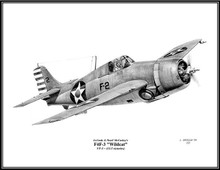 Loading... Please wait...
Loading... Please wait...- Home
- Combat Aircraft/Pencil Drawings ~ Free Shipping
- Grumman F4F-3 "Wildcat" (Lt.Cmdr. E.Scott 'Scott" McCuskey) ~ Free Shipping
Product Description
Print Size 8½" x 11" ----- Unlimited print edition
The Grumman F4F was the primary Navy and Marine Corps fighter during the first year and a half of World War II. A developed form, the General Motors FM-2, remained in active combat through the end of the Pacific War. Though the stubby little F4F could not equal the speed and maneuverability of its Japanese counterpart, the "Zero", its rugged construction and superior armament, coupled with well-trained pilots and good tactics, ensured that it generally gave at least "as good as it got" during the crisis months of 1942. The F4F-1 was a biplane design, whose clear inferiority to the monoplane Brewster F2A-1 caused its complete recasting into the single-wing XF4F-2. When the Brewster fighter was chosen for production, Grumman's prototype was rebuilt as the XF4F-3 with new wings and tail and a supercharged version of the Pratt & Whitney R-1830 "Twin Wasp" radial engine. Testing of the XF4F-3 led to an order for F4F-3 production models, the first of which was completed in February 1940. France also ordered the type, powered by Wright R-1820 "Cyclone" radial engines. These ultimately went to the British Royal Navy, which called them "Martlet I"s. Both the British planes and the U.S. Navy's F4F-3 joined active units in 1940 with an armament of four .50 caliber Browning machine guns and a good ammunition supply. By the end of 1941 the Grumman F4F-3 (and similar F4F-3A) fighters, which had received the popular name "Wildcat" a few months earlier, had replaced the F2A in most U.S. Navy and Marine Corps fighting squadrons. A folding-wing version flew in April 1941 and entered service in early 1942 as the F4F-4. Prompted by British tactical concepts, it had six guns but less ammunition. The heavier F4F-4 was not as nimble nor as fast as the F4F-3, but the logic of wartime manufacturing left it as the sole remaining production version, and its folding wings made it possible to cram more valuable fighters into each aircraft carrier. By the Battle of Midway in June 1942, all the Pacific Fleet's carriers had the F4F-4 and fighting squadron pilots were learning, sometimes painfully, how to best employ it. Employ it they did, quite successfully, through the Pacific's intense Guadalcanal and Central Solomons campaigns and the Atlantic's North African operation. In late 1942 and early 1943, Grumman phased out production of the F4F-4 and General Motors' Eastern Aircraft Division took it up as the FM-1 (with two less guns). In all, the two companies produced some three-thousand "Wildcats" for the U.S. and Britain before GM's factories switched to the updated FM-2 in the later part of 1943.
Warranty Information
null








